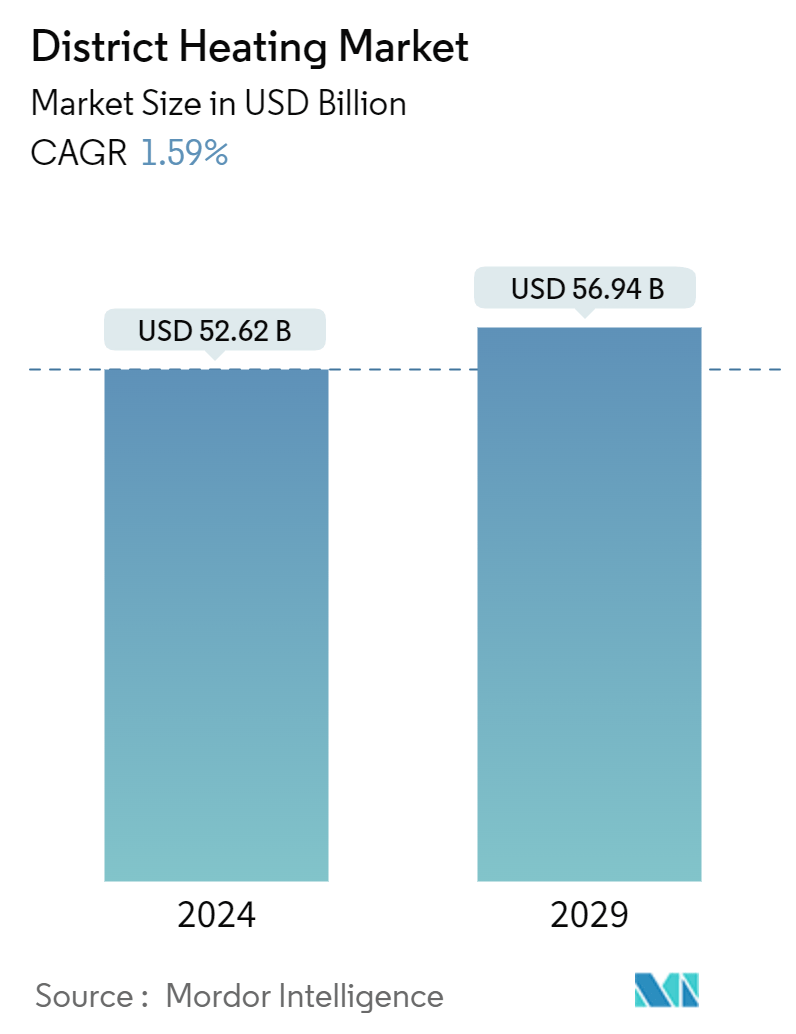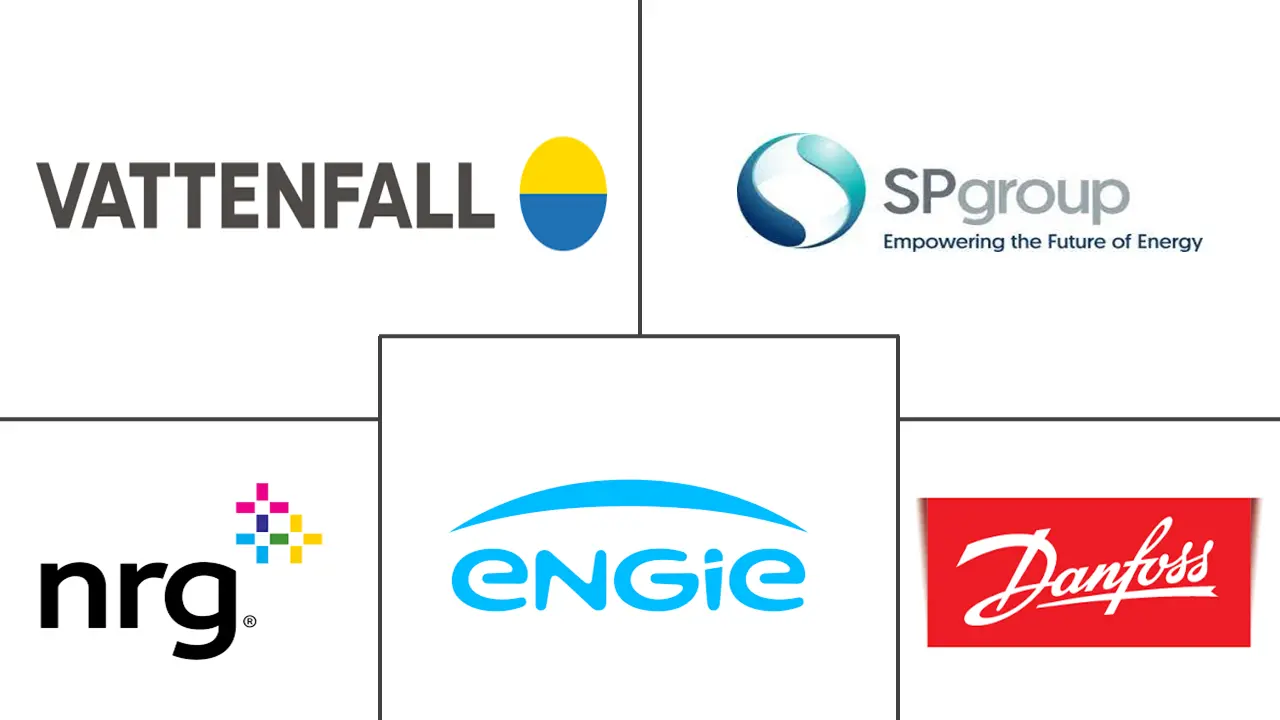Market Size of District Heating Industry

| Study Period | 2019 - 2029 |
| Market Size (2024) | USD 52.62 Billion |
| Market Size (2029) | USD 56.94 Billion |
| CAGR (2024 - 2029) | 1.59 % |
| Fastest Growing Market | Asia Pacific |
| Largest Market | Asia-Pacific |
Major Players
*Disclaimer: Major Players sorted in no particular order |
District Heating Market Analysis
The District Heating Market size is estimated at USD 52.62 billion in 2024, and is expected to reach USD 56.94 billion by 2029, growing at a CAGR of 1.59% during the forecast period (2024-2029).
District energy is a quick-growing industry globally, supported by the aggressive climate objectives set by the global economies. Based on initial assessments, these district heating and cooling companies have been recognized as operations that could produce more extraordinary growth and value potential with an alternative holding structure. By including electrically powered heat pumps in the district heating supply, higher renewable energy levels can be used for thermal purposes, generating integration and balance between energy systems. With a burgeoning global wind turbine capacity, big heat pumps will play a meaningful role in the sustained global green energy development and phasing out fossil fuels by 2050.
- District heating provides a method of delivering thermal energy to buildings (homes and commercial space) in the form of hot water through a distribution network of highly insulated pipelines. The potential for increased use of industrial district heating is limited because conversions of industrial processes to district heating involve varying heat loads amongst types of industries and processes.
- However, the conversion to district heating serves an 11% reduction in the use of electricity and a 40% reduction in the use of fossil fuels, with a total energy end-use saving of 6% among industries.
- Converting the industrial processes has led to a potential reduction of global carbon dioxide emissions by 112,000 tons per year. However, the residential and commercial markets are expected to hold a significant share.
- Approximately 60 million EU citizens are served by district heating, and an additional 140 million people live in cities with at least one district heating system. According to reports by the EU and the IEA, DH meets around 11-12% of the EU's heat demand via 6,000 district heating and cooling networks.
- With machine learning, the idea is to predict heat loads from customer data and operational data, along with weather forecasts, national holidays, weekdays, etc., to optimize and plan heat production, thereby lowering heat loss and handling peak loads. The potential is extended to intelligent algorithms in fault detection to identify leakages, inefficient heating systems, or errors from failure related to single components.
- In June 2024, Swedish SMR project developer Kärnfull Next has strategically partnered with Finnish counterpart Steady Energy to introduce SMRs for district heating in Sweden. The collaboration aims to capitalize on Kärnfull's unique financing structures and delivery models to introduce Steady Energy's renowned district heating reactors to the Swedish market.
District Heating Industry Segmentation
District heating (also recognized as heat networks or teleheating) is a system for distributing heat produced in a centralized place through insulated pipes for domestic and commercial heating necessities, such as water heating and space heating. The district heating system comprises a high-powered central boiler, well-insulated pipes hidden under the streets, a heat exchanger, and an added system (heat pump, solar power, boiler, etc.) to generate hot water separately in the summertime.
The district heating market is segmented by plant type (boiler plant, combined heat and power (CHP)), heat source (coal, natural gas, renewables, oil, and petroleum products), by application (residential, commercial, and industrial), and by geography (North America, Europe, Asia Pacific, Rest of the World). The report offers market forecasts and size in value (USD) for all the above segments.
| By Plant Type | |
| Boiler | |
| Combined Heat and Power (CHP) |
| By Heat Source | |
| Coal | |
| Natural Gas | |
| Renewables | |
| Oil and Petroleum Products |
| By Application | |
| Residential | |
| Commercial and Industrial |
| By Geography*** | |
| North America | |
| Europe | |
| Asia | |
| Australia and New Zealand | |
| Latin America | |
| Middle East and Africa |
District Heating Market Size Summary
The district heating market is experiencing steady growth, driven by global climate objectives and the integration of renewable energy sources. This system, which delivers thermal energy through insulated pipelines, is gaining traction as a sustainable alternative to traditional heating methods. The market is characterized by its ability to reduce electricity and fossil fuel consumption significantly, contributing to lower carbon emissions. The adoption of electrically powered heat pumps within district heating systems is enhancing the use of renewable energy, facilitating a transition towards greener energy solutions. This shift is particularly evident in industrialized nations, where district heating is well-established and offers benefits such as improved safety, reliability, and fuel flexibility. The market is also seeing increased interest in smart technologies, like machine learning, to optimize heat production and reduce energy loss.
In regions like Europe and Asia-Pacific, district heating is supported by government incentives and policies aimed at increasing the share of renewables in energy generation. The market is moderately competitive, with numerous global and regional players investing in research and development to innovate and expand their market presence. Strategic collaborations and acquisitions are common as companies seek to enhance their offerings and meet ambitious climate targets. The market's growth is further bolstered by rising disposable incomes and environmental concerns, particularly in countries like China and India. As the demand for efficient and sustainable heating solutions continues to rise, district heating is poised to play a crucial role in the global energy landscape, aligning with efforts to combat climate change and reduce emissions.
District Heating Market Size - Table of Contents
-
1. MARKET INSIGHTS
-
1.1 Market Overview
-
1.2 Industry Attractiveness - Porter's Five Forces Analysis
-
1.2.1 Bargaining Power of Suppliers
-
1.2.2 Bargaining Power of Consumers
-
1.2.3 Threat of New Entrants
-
1.2.4 Threat of Substitute Products
-
1.2.5 Intensity of Competitive Rivalry
-
-
1.3 Industry Value Chain Analysis
-
1.4 Impact of COVID-19 on the Market
-
1.5 Government Initiatives and Programs on District Heating Transition
-
1.6 Key Trends and Innovations in District Heating
-
-
2. MARKET SEGMENTATION
-
2.1 By Plant Type
-
2.1.1 Boiler
-
2.1.2 Combined Heat and Power (CHP)
-
-
2.2 By Heat Source
-
2.2.1 Coal
-
2.2.2 Natural Gas
-
2.2.3 Renewables
-
2.2.4 Oil and Petroleum Products
-
-
2.3 By Application
-
2.3.1 Residential
-
2.3.2 Commercial and Industrial
-
-
2.4 By Geography***
-
2.4.1 North America
-
2.4.2 Europe
-
2.4.3 Asia
-
2.4.4 Australia and New Zealand
-
2.4.5 Latin America
-
2.4.6 Middle East and Africa
-
-
District Heating Market Size FAQs
How big is the District Heating Market?
The District Heating Market size is expected to reach USD 52.62 billion in 2024 and grow at a CAGR of 1.59% to reach USD 56.94 billion by 2029.
What is the current District Heating Market size?
In 2024, the District Heating Market size is expected to reach USD 52.62 billion.

